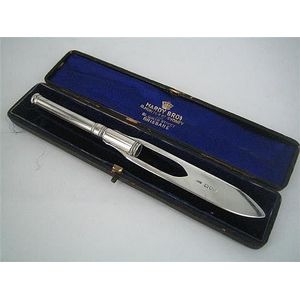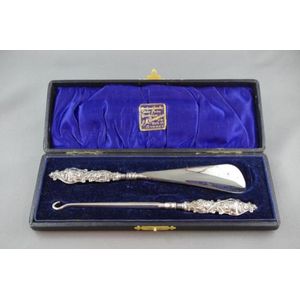English Serving Flatware Sets: Sterling & Silver Plated
You must be a subscriber, and be logged in to view price and dealer details.
Subscribe Now to view actual auction price for this item
When you subscribe, you have the option of setting the currency in which to display prices to $Au, $US, $NZ or Stg.
- Victorian Period - The Victorian period of furniture and decorative arts design covers the reign of Queen Victoria from 1837 to 1901. There was not one dominant style of furniture in the Victorian period. Designers used and modified many historical styles such as Gothic, Tudor, Elizabethan, English Rococo, Neoclassical and others, although use of some styles, such as English Rococo and Gothic tended to dominate the furniture manufacture of the period.
The Victorian period was preceded by the Regency and William IV periods, and followed by the Edwardian period, named for Edward VII (1841 ? 1910) who was King of the United Kingdom and the British Dominions and Emperor of India for the brief period from 1901 until his death in 1910. - Flatware - An alternative name for items of cutlery, principally knives, forks and spoons, now generally used to describe sets of these implements. Nowadays it is mostly used when describing cutlery made of silver and silver plate.
It is less frequently used to describe all "flat' items of tableware, so that as well as cutlery the definition includes plates. - Sterling Silver - Sterling silver is a mixture of 92.5% pure silver and 7.5% of another metal, usually copper. Fine silver is 99.9% pure silver, and is relatively soft and the addition of the very small amount of copper gives the metal enough strength and hardness to be worked into jewellery, decorative and household objects.
- Marrow Spoon - A spoon with a long handle and a narrow scoop shaped bowl, used to scoop and eat marrow from the hollow centre of roasted bones. Some marrow scoops are double ended with a different shaped bowl at each end.
This item has been included into following indexes:
Visually similar items

A Victorian diamond and 15ct gold bar brooch, double tapered, with applied bead, leaf and rope; nickel pin; Birmingham 1895. (repaired) (cased for Fattorini) weight 2.6g.

A late-Victorian silver letter opener/with propelling pencil; Sampson Mordan & Co., London 1898. Length 18 cm. (fitted case)

Sterling silver handle shoe horn & button hook in black leatherette covered case, hallmarked Birmingham 1901, case 20.5 cm wide

Edwardian hallmarked sterling silver four piece ladies accessory set. Boxed. Birmingham 1901. Maker, H. Matthews, including hair crimper, glove stretcher (ivory arms restored), boot button hook & shoe horn.
